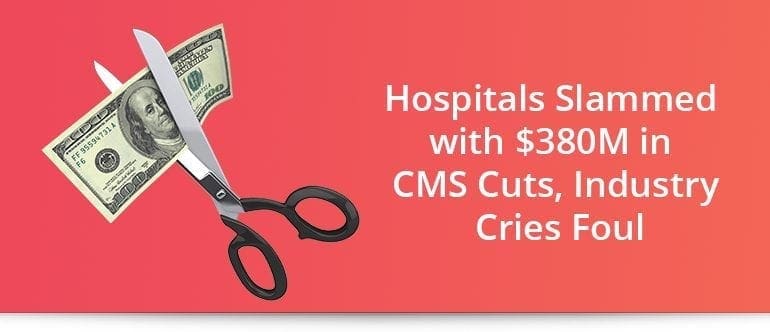Call us toll-free: 800-878-7828 — Monday - Friday — 8AM - 5PM EST

By Samantha Liss for Healthcare Dive
Dive Brief:
- With its final Outpatient Prospective Payment System (OPPS) rule for 2019, CMS is eliminating the pay discrepancy Medicare beneficiaries face visiting a hospital-owned outpatient setting as opposed to a traditional doctor’s office. CMS said cutting reimbursement at hospital-owned outpatient settings for these visits will save Medicare $380 million in 2019 alone. The American Hospital Association promptly vowed to sue.
- On the 340B front, the agency is expanding payment cuts to off-site hospital departments in a bid to keep hospitals from shifting their pharmacy services to off-campus facilities. By doing this, hospitals receive higher payment rates, so CMS’ move is sure to anger safety net hospitals.
- The agency is also allowing Medicare beneficiaries to receive more care outside of hospitals by adding 12 additional procedures at ambulatory surgical centers, a move supplemented by reductions to reporting requirements for both ASCs and hospitals. Those reporting cuts are expected to save providers $27 million over the next two years, according to CMS.
Dive Insight:
As hospitals continue to gobble up competitors and physician practices, consolidation has had a perverse affect on where Medicare beneficiaries are getting low-acuity care and how much Medicare is paying for those services.
A 2015 GAO report found that after acquiring a physician practice, a shift occurred where more patients were seen at the higher-cost setting of a hospital outpatient facility rather than the lower-cost option of a traditional doctor’s office.
“While vertical consolidation has potential benefits, we found that the rise in vertical consolidation exacerbates a financial vulnerability in Medicare’s payment policy: Medicare pays different rates for the same service, depending on where the service is performed,” the GAO report found.
CMS’ final rule issued Friday is an attempt at creating “a level playing field” for providers, CMS administrator Seema Verma said in a statement.
The change is expected to save Medicare $380 million in 2019 alone, adding up to a sizable payment cut for hospitals.
Tom Nickels, Executive Vice President of the American Hospital Association (AHA) railed against CMS’ “ill-advised” payment cuts to outpatient clinics, arguing further that the rule is “based on unsupportable analyses and erroneous policy rationales” that will hit rural patients and vulnerable communities hardest.
Even so, the final rule eases up a bit compared to an earlier proposal, by spreading out the site-neutral cuts over two years.
And overall, factoring in the cuts and payment rate increases, reimbursement on a net basis will rise slightly, 0.6%, for nonprofit hospitals and 1% for for-profit, according to the final rule. Height analysts said that’s an improvement from the proposed rule in which nonprofits net reimbursement would have been negative.
Friday’s rule also would allow ambulatory surgical centers to do more, creating another threat to hospitals. Under the rule, ASCs could provide and be reimbursed for 12 additional procedures, mainly for cardiovascular issues, according to CMS.
The agency was expected to extend 340B payment cuts to previously exempt off-campus providers, a move proposed in July that received swift pushback from safety net hospital advocates and the hospital industry at large.
Maureen Testoni, interim president of advocacy group 340B Health, said in a statement that her organization is disappointed in the “misguided and damaging policy,” and encouraged Congress to move to reverse the cuts.
“Cutting Medicare payments for drugs for patients treated in 340B hospitals by nearly 30% will damage the healthcare safety net that serves uninsured, underinsured, and Medicaid patients across the country,” Testoni said. “We have already seen the negative impact these cuts are having on patient care. Our member hospitals report that they have had to cut back on services and have had to forgo hiring or lay off doctors, nurses, pharmacists, and other healthcare professionals.”
When CMS proposed extending 340B cuts to off-campus facilities in July, the American Hospital Association argued that the agency “misconstrued Congressional intent” to provide off-campus clinics with the existing outpatient payment rate. If CMS were to go through with the rule, AHA said at the time, it would ultimately “impede access to care for the most vulnerable patients” instead.
AHA, according to Nickels, intends to rally with other industry groups and “promptly bring a court challenge to the new rule’s site-neutral provisions.” AHA and a handful of other hospital associations are already in a legal battle with HHS over its 340B cuts.
